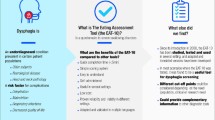Abstract
Recent and specific data on the prevalence and/or incidence of oropharyngeal dysphagia in the general population are scarce. This study focuses on obtaining this data by means of a literature review and telephone survey. A literature review was performed to obtain data on the prevalence of dysphagia in the general population. Secondly, a quasi-random telephone survey using the functional health status questionnaire EAT-10 was conducted with the aim of establishing prevalence data on oropharyngeal dysphagia in the Netherlands. The literature review revealed six articles which met the inclusion criteria. The prevalence data on oropharyngeal dysphagia in the general population varied between 2.3 and 16 %. For the telephone survey, a total of 6,700 individuals were contacted by telephone, of which, 2,600 (39 %) participated in the study. Of the 2,600 participants, as many as 315 (12.1 %) were identified as having swallowing abnormalities and showed increased risk of oropharyngeal dysphagia with age. Prevalence data on oropharyngeal dysphagia in the Dutch general population were as high as 12.1 %. This data are in line with the retrieved prevalence data from the literature.



Similar content being viewed by others
References
Wilkins T, Gillies RA, Thomas AM, Wagner PJ. The prevalence of dysphagia in primary care patients: a hamesnet research network study. J Am Board Fam Med. 2007;20:144–50.
Cook IJ, Kahrilas PJ. AGA technical review on management of oropharyngeal dysphagia. Gastroenterology. 1999;116:455–78.
Martino R, Pron G, Diamant N. Screening for oropharyngeal dysphagia in stroke: insufficient evidence for guidelines. Dysphagia. 2000;5(1):19–30.
Ekberg O, Hamdy S, Woisard V, Wuttge-Hannig A, Ortega P. Social and psychological burden of dysphagia: its impact on diagnosis and treatment. Dysphagia. 2002;17:139–46.
Marik PE, Kaplan D. Aspiration pneumonia and dysphagia in the elderly. Chest. 2003;124:328–36.
Sharma JC, Fletcher S, Vassallo M, Ross I. What influences outcome of stroke-pyrexia or dysphagia? Int J Clin Pract. 2001;55:17–20.
Meng NH, Wang TG, Lien IN. Dysphagia in patients with brainstem stroke: Incidence and outcome. Am J Phys Med Rehabil. 2000;79:170–5.
Mann G, Hankey GJ, Cameron D. Swallowing disorders following acute stroke: prevalence and diagnostic accuracy. Cerebrovasc Dis. 2000;10(5):380–6.
García-Peris P, Parón L, Velasco C, de la Cuerda C, Camblor M, Bretón I, Herencia H, Verdaguer J, Navarro C, Clave P. Long-term prevalence of oropharyngeal dysphagia in head and neck cancer patients: impact on quality of life. Clin Nutr. 2007;26(6):710–7.
Chiocca JC, Olmos JA, Salis GB, Soifer LO, Higa R, Marcolongo M. Prevalence, clinical spectrum and atypical symptoms of gastro-oesophageal reflux in Argentina: a nationwide population-based study. Aliment Pharmacol Ther. 2005;22:331–42.
Cho YS, Choi MG, Jeong JJ, Chung WC, Lee IS, Kim SW, Han SW, Choi KY, Chung IS. Prevalence and clinical spectrum of gastroesophageal reflux: a population-based study in Asan-si. Korea. Am J Gastroenterol. 2005;100(4):747–53.
Eslick GD, Talley NJ. Dysphagia: epidemiology, risk factors and impact on quality of life-a population-based study. Aliment Pharmacol Ther. 2008;27(10):971–9.
Ruth M, Månsson I, Sandberg N. The prevalence of symptoms suggestive of esophageal disorders. Scand J Gastroenterol. 1991;26(1):73–81.
Watson DI, Lally CJ. Prevalence of symptoms and use of medication for gastroesophageal reflux in an Australian community. World J Surg. 2009;33(1):88–94.
Ziółkowski BA, Pacholec A, Muszunski JT. Alarm symptoms, risk factors for digestive tract cancer and readiness to participate in an endoscopic screening program. Prz Gastroenterol. 2013;8(2):108–14.
Speyer R, Cordier R, Kertscher B, Heijnen B. Psychometric properties of questionnaires on functional health status in oropharyngeal dysphagia: a systematic literature review. BioMed Res Int. 2014. doi:10.1155/2014/458678.
Belafsky PC, Mouadeb DA, Rees CJ, Pryor JC, Postma GN, Allen J, Leonard RJ. Validity and reliability of the eating assessment tool (EAT-10). Ann Otol Rhinol Laryngol. 2008;117(12):919–24.
Rofes L, Arreola V, Mukherjee R, Clavé P. Sensitivity and specificity of the eating assessment tool and the volume-viscosity swallow test for clinical evaluation of oropharyngeal dysphagia. Neurogastroenterol Motil. 2014;26(9):1256–65.
Roden DF, Altman KW. Causes of Dysphagia among different age groups-A systematic review of the literature. Otolaryngol Clin N Am. 2013;46:965–87.
Cichero JA, Altman KW. Definition, prevalence and burden of oropharyngeal dysphagia: a serious problem among older adults worldwide and the impact on prognosis and hospital resources. Nestle Nutr Inst Workshop Ser. 2012;72:1–11.
Conflict of interest
None.
Author information
Authors and Affiliations
Corresponding author
Rights and permissions
About this article
Cite this article
Kertscher, B., Speyer, R., Fong, E. et al. Prevalence of Oropharyngeal Dysphagia in the Netherlands: A Telephone Survey. Dysphagia 30, 114–120 (2015). https://doi.org/10.1007/s00455-014-9584-z
Received:
Accepted:
Published:
Issue Date:
DOI: https://doi.org/10.1007/s00455-014-9584-z




